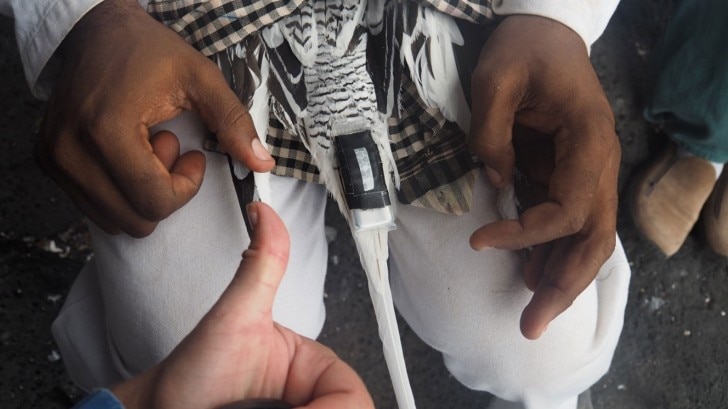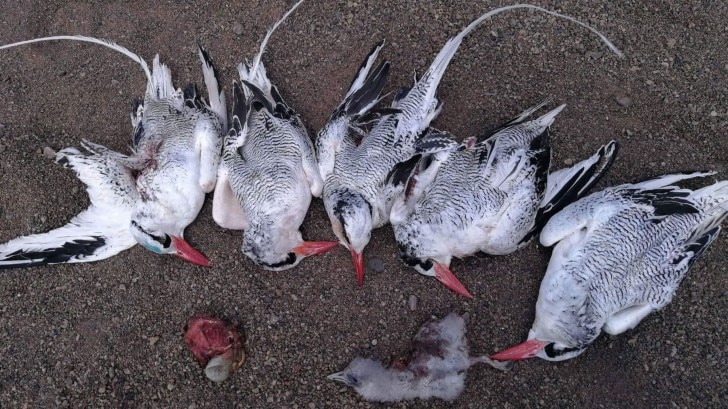BBC Earth newsletter
BBC Earth delivered direct to your inbox
Sign up to receive news, updates and exclusives from BBC Earth and related content from BBC Studios by email.
Birds
You may not have heard of pelagic birds before, but you will be familiar with several members of the family.
Albatross, frigate birds, petrels, puffins, boobies and even penguins are all kinds of pelagic seabirds and what this means is that they spend a significant portion of their lives at sea. Relying on marine prey for food, pelagic birds only come to land to breed.
They are often found hundreds, if not thousands, of miles offshore enduring colossal storms. It’s impossible not to immediately fall in love with them once you see a seabird “surfing” on the wind on a stormy day.
Unfortunately, these birds have suffered huge population decline over the recent decades due to threats on land (such as introduced predators) and at sea (such as accidental mortality in some fishing gears, notably longlining, and the collapse in some fisheries). To stop these declines, we need to learn about their basic biology, which areas they use year-round and identify the main threats in each of these areas. However, this information is often lacking, particularly in species breeding in difficult to access places.
One such bird is the red-billed tropicbird (Phaethon aethereus). This little-known species breeds on rocky crevices or on ground of oceanic islands in the tropical waters of the Atlantic and Pacific Oceans and in the northern Indian Ocean. We began to study red-billed tropicbirds within the context of a big project for the conservation of seabirds in Cape Verde, funded by MAVA Foundation, coordinated by BirdLife International and with multiple partners such as Cape Verde organisations (Nacional Direction of the Environment and National Parks and Protected Areas), NGOs (Sociedade Portuguesa para o Estudo das Aves, Projeto Biodiversidade, Projecto Vitó, Biosfera, Fundação Maio Biodiversidade, Bios.CV) and the universities of Barcelona, Coimbra and Cape Verde.



In 2017, biologists of the NGO Project Biodiversity found an accessible colony of red-billed tropicbirds on Sal Island, Cape Verde - the largest colony of this species in the Western Atlantic-, so far unknown to science. At this location, we can easily study the species, understand its main threats and thus contribute to its conservation.
First, we individually mark every bird in the colony with a unique identifier ring. This is called scientific ringing and allows us to estimate the size of the population, the survival at different stages of their live, and ultimately the viability of the populations.
Once ringed, we take some biometric measurements, check if the bird is moulting any flight feathers (as the moulting pattern of this species is still fairly unknown) and check for fault bars (small defects in the feathers caused by problems through moulting or lack of food). Since seabirds normally moult their feathers during the non-breeding period, the presence of fault bars can help us understand the stress suffered during a period when birds are inaccessible to researchers while out at sea.

One of the advantages of studying the red-billed tropicbirds in the golden age of animal tracking is that technological advances have given us small, accurate and powerful devices, such as GPS and geolocators, to study the areas used by seabirds year-round. We deploy GPS dataloggers on the base of their tails to determine the foraging areas the birds use during the breeding period. They also indicate the location of tropicbird feeding areas, which routes they use and their activity and behaviour while at sea. All this information can then be used to identify the main marine areas important for the species and to understand the threats birds face at sea, such as seabird by-catch in some fisheries.
Currently, GPS devices have a short battery life and are still too large to track birds year-round, but this can be overcome with the deployment of geolocators on the legs of the birds. Geolocators are miniature devices that record ambient light levels every few minutes. The light data obtained from geolocators is used to determine the day length and the time of solar noon, which allows us to estimate latitude and longitude twice a day. Before the emergence of geolocation, information on the migratory movements of pelagic seabirds was scarce, biased and fragmentary. Indeed, we still do not know where Cape Verdean red-billed tropicbird spend their non-breeding period, whether they stay near Cape Verde waters all year-round or migrate somewhere in the Atlantic. Geolocators are deployed during the breeding period and need to be recovered after one year to download the stored light levels, which we then use to infer the migratory movements outside of the breeding period, allowing us to determine the migratory pathways and main non-breeding areas.

Tropicbirds have evolved breeding on islands without mammal predators and therefore these birds do not have effective ways to protect themselves from this type of predation. Humans introduced cats, dogs and rats nearly in every island around the world, since then red-billed tropicbirds are threatened by these mammals, which predate on adults, juveniles and eggs. Below you can see a cat photographed by a cameratrap pointing out to a red-billed tropicbird nest. A couple of adults and eggs disappeared after this picture was taken.
Furthermore, in the beginning of this year, in the colony where the documental was filmed, some wild dogs killed 18 adults and 5 chicks.

Red-billed tropicbirds are also being harvested by locals who eat them. Sadly, in January we found eight adults killed nearby one of our main monitoring sites for the species at Boavista, Cape Verde.
Seabird populations are very sensitive to an increase in adult mortality; since the strategy of this group of birds lies in living for many years; some seabirds can live more than 50 years! Many species, such as tropicbirds, only start breeding after a few years of age and lay a single egg each year. In consequence, the levels of cat, dog and rat predation and human harvesting we found in Cape Verde are very alarming and can have important consequences on the population viability, even leading to the extinction of the species in Western Africa. Unfortunately, few efforts have been done so far to control these threats.
Therefore, there is an urgent need to control cat, dog and rat populations in the areas around red-billed tropicbird colonies and to raise awareness of local people, so they understand the consequences of harvesting of this species. Cape Verde has already lost one of its most emblematic seabird species, the frigatebird, and other bird species, such as the Egyptian vulture, are very close to extinction in the archipelago. Clearly, it is urgent to involve Cape Verdeans in the conservation of the red-billed tropicbirds before it is too late.
Teresa Militão is a biologist studying seabird ecology and conservation over the last 10 years, focusing mainly in Macaronesian and Mediterranean species. She did her PhD thesis about the migratory ecology of pelagic seabirds and the use of stable isotope analysis as a geographic marker of seabird non-breeding distribution. But her research interests go beyond migratory ecology, encompassing conservation biology and population dynamics. Nowadays, she is the coordinator of the conservation activities developed by the University of Barcelona in Cape Verde within the project “Promoting the conservation of seabird in West Africa” funded by MAVA Foundation.
Featured image © Paul Souders/Getty